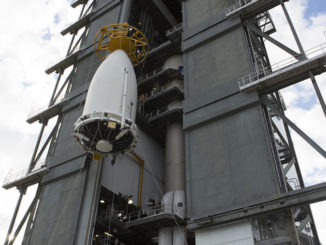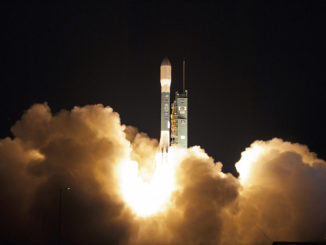
United Launch Alliance’s second-to-last Delta 4-Heavy rocket is scheduled to blast off from Cape Canaveral April 20 with a classified cargo for the U.S. government’s spy satellite agency, a mission that will mark ULA’s first flight of the year, officials announced this week.
ULA and the National Reconnaissance Office, the customer for the national security mission, announced the target launch date Tuesday.
The mission is known as NROL-68, and is expected to loft a large surveillance satellite into geosynchronous orbit, joining a fleet of government-owned spacecraft designed to eavesdrop on the communications of adversaries and foreign powers. But the NRO does not disclose details about its missions, and independent analysts use information about the rocket’s lift capability, trajectory, and similar past launches to predict the purpose of spy satellite missions.
“Everything’s looking great and we’re on track to launch another vitally important national security capability into space,” said Maj. Gen. Stephen Purdy, the U.S. Space Force’s program executive officer for assured access to space. “This will be our third national security launch this year.”
“These launches place critical capabilities into orbit for our nation and our allies in what are dynamic times for the space community,” Purdy said in a statement. “Every member of our launch team understands what’s at stake and works with care and efficiency to prepare for what’s going to be a tremendous launch.”
ULA, a 50-50 joint venture between Boeing and Lockheed Martin, is retiring the Delta family of rockets in favor of the new-generation Vulcan launch vehicle, which is scheduled to make its first test flight as soon as early May from Cape Canaveral. The Vulcan rocket will also replace ULA’s Atlas 5 launcher, which will fly 19 more times before retirement later in the 2020s.
There are just two more Delta rockets remaining in ULA’s backlog. Both missions will use the most capable version of the Delta rocket, the Delta 4-Heavy, made by combining three large booster cores together to create a triple-body rocket. The three Aerojet Rocketdyne RS-68A engines, burning super-cold hydrogen fuel, will generate 2.1 million pounds of thrust at full power.
The launch set for April 20 will be the 15th flight of a Delta 4-Heavy rocket, which debuted in 2004, and the 44th flight of the Delta 4 family since 2002. The primary customer for ULA’s Delta 4 rocket has been the U.S. military and the NRO.
The Delta 4 rocket program, originally developed by Boeing, followed the Delta 2 rocket, a workhorse for NASA, the U.S. military, and commercial satellite operators in the 1990s and 2000s.

The Atlas 5 and Delta 4 rockets currently flown by ULA show little resemblance to their forebears, but the names are steeped in history. Rockets bearing the Delta name began launching in 1960, and 387 Delta rockets have flown to date, most recently a Delta 4-Heavy launch from Vandenberg Space Force Base in California in September. That was the final Delta launch from the West Coast spaceport.
Both Delta 4-Heavy rockets left to fly will blast off from pad 37B at Cape Canaveral on missions for the NRO. The final Delta 4-Heavy will launch the NROL-70 mission in 2024.
ULA ground teams at Cape Canaveral integrated the Delta 4-Heavy’s three hydrogen-fueled boosters after the hardware arrived from the company’s factory in Decatur, Alabama. Then technicians attached the rocket’s upper stage, powered by an Aerojet Rocketdyne RL10 engine, before rolling the rocket to the pad and lifting it vertical earlier this year.
The launch team completed a practice countdown, or wet dress rehearsal, on the Delta 4-Heavy rocket Monday. The dress rehearsal involved loading thousands of gallons of super-cold liquid hydrogen and liquid oxygen into the Delta 4-Heavy on pad 37B.
The mission set for launch April 20 will be the first launch from pad 37B since December 2020.
With the practice countdown complete, ground crews will next hoist the top secret payload for the NROL-68 mission on top of the Delta 4-Heavy inside the launch pad’s mobile gantry structure. A separate team is readying the spacecraft at a separate payload processing facility clean room at Cape Canaveral.
The Delta 4-Heavy rocket will stand 235 feet (71.6 meters) tall when fully stacked on the launch pad.

After a few weeks of final checkouts and preparations, ULA will wheel the mobile gantry into position to reveal the Delta 4-Heavy for liftoff. Six hours after launch, the rocket will deploy its classified payload into geosynchronous orbit more than 22,000 miles (nearly 36,000 kilometers) above Earth and closely hugging the equator.
Reaching such an orbit required the rocket to follow one of the most challenging flight profiles in the launch business, with three burns expected by the Delta’s upper stage to deploy its satellite payload at the targeted altitude.
While ULA preps the Delta 4-Heavy for liftoff from pad 37B, the company is working on the first flight-qualified Vulcan rocket a few miles to the north at pad 41. The Vulcan launch team completed a pair of tanking tests on the first stage of the Vulcan rocket and its Centaur upper stage, an upgraded, larger version the upper stage flown on the Atlas 5 rocket.
The Vulcan rocket will be powered by two Blue Origin-built BE-4 engines on the first stage.
Later this spring, ULA plans to ignite the Vulcan rocket’s BE-4 engines for a brief hold-down test-firing at pad 41, then roll the Vulcan rocket back to its vertical hangar, where technicians will install two strap-on solid rocket boosters and the payload fairing.
The inaugural test flight of the Vulcan rocket will carry into space an Astrobotic commercial moon lander and two prototype satellites for Amazon’s Kuiper broadband network.
Email the author.
Follow Stephen Clark on Twitter: @StephenClark1.



